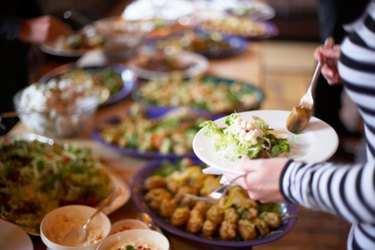
A banquet, whether for a fundraiser, wedding or other affair, requires detailed planning ranging from the venue to the caterer to the banquet style. From formal to informal, the type of banquet service varies widely depending on the menu, serving style, number of staff needed and the number of guests. When planning your affair, you can combine different styles of banquet service to accommodate special guests or keep the attendees socializing while the photographer or videographer documents your event.
Sit-Down Dinner
Video of the Day
A sit-down, or plated, dinner is often seen at conferences, formal events and weddings. This formal style of serving requires extra servers. The plates are prepared in the kitchen and are served individually to the guests at their tables. There are a number of options, including having the dinner served in courses so that the salads and/or soups arrive, and while everyone is enjoying the food, the dinner plates are being prepped in the kitchen.
Video of the Day
While efficient from the caterer's point of view, your guests may have to wait a few minutes for their plates to arrive at their tables. On the other hand, there is less food waste since the main dish and sides are portioned out in the kitchen. In addition, special plates to accommodate dietary needs can be determined in advance and served to your guests with a minimum of fuss.
Stations Around the Room
To encourage socializing, a station-style banquet service utilizes small tables scattered around the perimeter of the banquet hall, each with different courses and/or cuisines. Your guests can wander from station to station, selecting their favorites and self-serving. If you prefer, the catering staff can serve the food. At high-end events, chefs may prepare the food according to the guests' requests. Stations may include appetizers, an oyster bar, sushi, salads, pastas, main dishes, side dishes, candies and desserts.
Buffet With Servers
A buffet with servers, sometimes called "cafeteria style," allows the caterer to control portions, particularly when serving rich sauces and specialty dishes that may be more filling than the guests realize. While there may be a single line – unless you set up two sets of buffet tables with the servers in the middle so you have a two-sided buffet – it moves efficiently since the server dishes up the food according to the guests' requests. It also keeps possible cross-contamination at a minimum since only the servers handle the serving spoons, ladles or tongs at each chafing dish or serving bowl.
In addition, the caterer or a member of the catering staff can direct each table to the buffet to avoid a long line of guests snaking around the room. This also ensures that the honored guests and elders are first at the buffet.
Self-Serve Buffet Style
Depending on the event, a self-serve buffet may be the best choice. All of the chafing dishes and serving bowls are uncovered when dinner is announced, and the guests line up to serve themselves. A buffet can be two-sided to speed the line, with serving utensils on each side so two people can serve themselves at each chafing dish. While guests often line up without prompting, it's more efficient to direct individual tables to join the line, thus avoiding a long line of hungry guests.
Combination Banquet Style
Don't hesitate to combine banquet styles according to the event. Catering staff can circulate with appetizers and beverages, or you can set up appetizer stations in a separate area while the buffet or plates for a sit-down dinner are prepared. A buffet or sit-down dinner may have individual salads or a family style salad bowl, bread in baskets and butter already at the tables for the guests to enjoy while they wait for their plates or their turn at the buffet.
Desserts can also be handled in a variety of ways. You can have desserts served at the table, wheeled from table to table on serving carts or arranged at stations for the guests to select and enjoy after finishing the main meal.